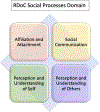Neural systems underlying RDoC social constructs: An activation likelihood estimation meta-analysis
- PMID: 36436737
- PMCID: PMC9843621
- DOI: 10.1016/j.neubiorev.2022.104971
Neural systems underlying RDoC social constructs: An activation likelihood estimation meta-analysis
Abstract
Neuroscientists have sought to identify the underlying neural systems supporting social processing that allow interaction and communication, forming social relationships, and navigating the social world. Through the use of NIMH's Research Domain Criteria (RDoC) framework, we evaluated consensus among studies that examined brain activity during social tasks to elucidate regions comprising the "social brain". We examined convergence across tasks corresponding to the four RDoC social constructs, including Affiliation and Attachment, Social Communication, Perception and Understanding of Self, and Perception and Understanding of Others. We performed a series of coordinate-based meta-analyses using the activation likelihood estimate (ALE) method. Meta-analysis was performed on whole-brain coordinates reported from 864 fMRI contrasts using the NiMARE Python package, revealing convergence in medial prefrontal cortex, anterior cingulate cortex, posterior cingulate cortex, temporoparietal junction, bilateral insula, amygdala, fusiform gyrus, precuneus, and thalamus. Additionally, four separate RDoC-based meta-analyses revealed differential convergence associated with the four social constructs. These outcomes highlight the neural support underlying these social constructs and inform future research on alterations among neurotypical and atypical populations.
Keywords: Activation likelihood estimation (ALE); Coordinate-based meta-analysis (CBMA); Functional magnetic resonance imaging (fMRI); Meta-analysis; Research domain criteria (RDoC); Social processes; Social task.
Copyright © 2022 The Authors. Published by Elsevier Ltd.. All rights reserved.
Conflict of interest statement
Competing interests The authors declare no competing interests.
Figures






References
Publication types
MeSH terms
Grants and funding
LinkOut - more resources
Full Text Sources

